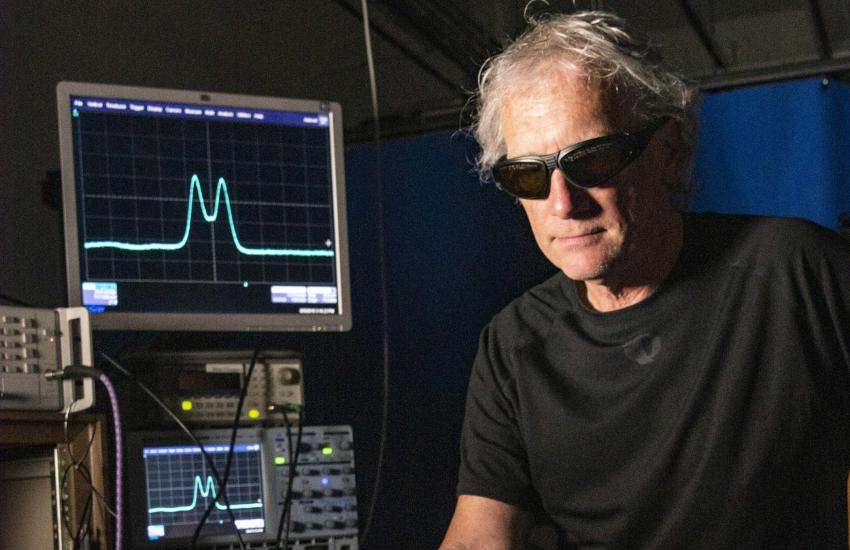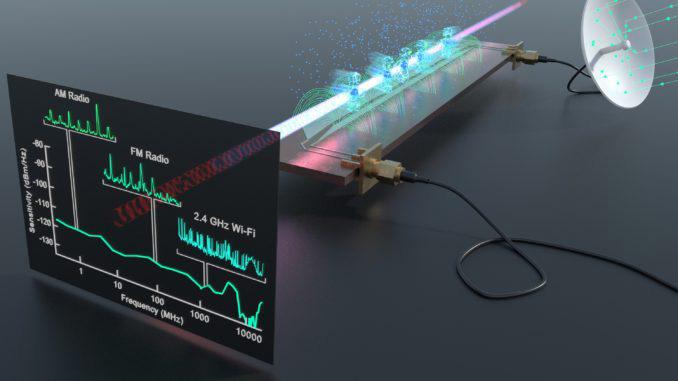Quantum Sensors Poised for Action
The next big thing in sensor technologies may come in a tiny package. Advances in atom-based sensors could allow the technology to migrate from the lab to practical use on the battlefield and elsewhere, experts say.
Rydberg sensors take advantage of the ability of so-called Rydberg atoms to react in different ways when exposed to varying kinds of electromagnetic fields. Such atom-based receivers will be smaller and lighter while requiring less power and may work better in challenging spectrum environments than conventional radio receivers. They offer new potential for communications, spectrum awareness and analysis, and for electronic warfare.
For example, Rydberg receivers may be able to detect very weak electromagnetic signals that would not be picked up by traditional technology. They may also prove useful for climate monitoring and a variety of other purposes, including more mundane tasks such as measuring or calibrating voltage.
A flurry of events in recent years demonstrates the growing interest and scientific advances in atom-based receivers. For example, The Defense Advanced Research Projects Agency announced in August of last year the teams for its Quantum Apertures program and followed the next month with an announcement of teams for the Science of Atomic Vapors for New Technologies (SAVaNT) program.
Additionally, the Army Research Laboratory proved last year that a quantum sensor can analyze the full spectrum of radio frequency and real-world signals, detecting amplitude modulation (AM) and frequency modulation (FM), Bluetooth, Wi-Fi (Wireless Fidelity) and other signals. And earlier this year, researchers at the National Institute of Standards and Technology (NIST) used a headphone-shaped copper device to boost the sensitivity of an atomic radio receiver by a hundredfold and proved that Rydberg atoms can detect television and video game transmissions.
Christopher L. Holloway, NIST project leader for the Rydberg Sensor Project and leader of the Electromagnetic Field Group, noted that he has studied quantum receivers for at least 15 years, but recent breakthroughs have led to an explosion of interest for researchers in the United States and worldwide. “We started this 15 years ago, maybe 16 years ago. There was us and maybe one or two other groups around the world working in this area. Now, in the past four years, it has just exploded. I probably have a company call me every couple of weeks, maybe every month, different companies wanting to get involved in this.”
That interest includes large and small businesses, academia and governments. For example, the Defense Advanced Research Projects Agency’s SAVaNT and Quantum Apertures programs have drawn interest from Holloway’s team at NIST, as well as Honeywell, Northrop Grumman, SRI International, ColdQuanta Inc., Quantum Valley Ideas Laboratory in Canada, Rydberg Technologies, Twinleaf LLC, Georgia Institute of Technology, University of Colorado, University of Maryland and the College of William and Mary. At least one company, Rydberg Technologies, offers a variety of products its website describes as compact, including optical frequency trackers, atomic vapor cells, AM/FM atomic receivers and a magnetic field probe.
Holloway credited recent advances for the growing interest. “This is still in the research stages, but since we’re getting closer to having a deployable device and because of some of the benefits and some of the applications we’ve shown, other groups around the world are starting to look at this now.”
A receiver no larger than a shoebox is the goal for practical use, according to both Holloway and James Tucker Swindell, chief of the Radio Frequency Communications Division within the U.S. Army’s Command, Control, Communications, Computer, Cyber, Intelligence, Surveillance and Reconnaissance (C5ISR) Center. “We believe that something around a shoebox size would be palatable in terms of a capability that we could bring to bear that would absolutely advance our current receive technologies but also be something that our soldiers can reasonably incorporate into their existing systems,” Swindell told SIGNAL Magazine.
Holloway echoed Swindell’s comment. “If we get it down to the size of a shoebox—and that includes the lasers and detectors and so forth—then you could start putting these things maybe in mobile, air-based platforms for whatever the military wanted to do, or from an environmental scientist viewpoint who wants to do climate monitoring. You could actually put these in airplanes and satellites.”
The NIST team uses two colored lasers—one red but invisible to the naked eye at 780 nanometers in diameter. “NIST developed this in a chip-scale atomic clock. It’s about the size, maybe if you took eight quarters and stacked them on top of each other. That includes this little atomic clock, vapor cell, lasers and power supply,” he explained.
The other laser, known as a coupling laser, is either blue or green and visible. “As we’re probing the atoms, we turn on this second colored light, this coupling laser, and that’s what generates these atoms into these Rydberg states, these high energy states. The probe laser’s how we read out the response of the atom,” Holloway added.
The coupling laser remains one of the biggest challenges to fielding a mobile Rydberg receiver. “Right now, we don’t have portable blue or green lasers that give us enough power to do the measurement,” Holloway said.

Ultimately, however, atomic receivers could offer a size, weight and power advantage over conventional sensors in part because they do not require antennas or some of the other traditional electronics. “The big benefit we get from this is that in a conventional receiver, you have an antenna that captures the energy, and there’s all these electronics that do things like a down-converting of the signal. It first demodulates it; then down-converts it,” Holloway elaborated. “Atoms do all that. They receive it. They act as the antenna. And they do all the down-converting for you, so therefore, you don’t need those types of antennas and front-end electronics that you would normally have in a conventional system.”
Atomic sensors may even push beyond the capabilities of current communications technologies. “There’s the potential out there that maybe you could start detecting much more sensitive signals. You could start doing things maybe that you couldn’t do with conventional systems,” Holloway said.
Furthermore, the atoms can be used forever, as long as the containers that house them remain intact. The technique requires a pure element like cesium that cannot be exposed. “The atom’s not going to wear out. That’s the beauty of this. We’ve got several of these vapor cells in the lab that we’ve been using for 15 years,” Holloway reported. “What might wear out is your vapor cell. You’ve got this thing you’re trying to hold these atoms in, and if for whatever reason this vapor cell loses vacuum, the atom could either escape, or you get other elements, other air that can come back into the vapor cell.”
And those vapor cells remain another challenge. “It’s not trivial getting just the atom we want in a glass container. It’s a little complicated making these, and as a result, sometimes it’s difficult to make very reliable devices that are always going to have the right number of atoms, the right non-contaminate gases. That’s a little problematic, but people are making real strides in that,” he said.
The NIST team also works with NASA to develop space-based sensors, Holloway said. The NASA Jet Propulsion Laboratory’s Cryospheric Rydberg Radar program builds on atomic receiver technology to remotely sense ice flow, ice-shelf evolution, snow accumulation and bedrock mapping. “It’s for the purpose of trying to see if we can put these sensors in space in a few years and then use that to do monitoring, some type of sensing of the Earth and maybe even other planets.”





Comments